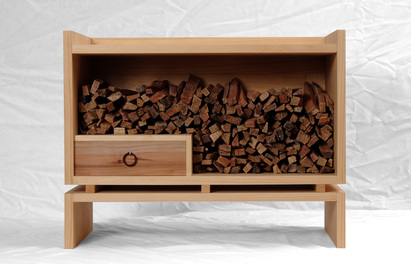 So, this is what happens when two other guys at Fine Woodworking make kindling boxes and I decide that I should make one too. One of the other guys is John Tetreault and his box will be shown in the Handwork department of FWW #253. The second guy is Mike Pekovich. Here's a picture of his. What both of their boxes have in common is that the opening is on top of the box, and that makes perfect sense given the job their designed to do. When I began thinking about a kindling box (actually mine is a box for fatwood), I was thinking of having the opening on top, but using a lid on hinges so that it would be neat and tidy--in keeping with my overall preference for clean lines. However, something about that struck me as odd, and I don't really know why, but I thought to myself, just turn it onto its side. The fatwood I used to start my wood stove is of a uniform length and can be stacked easily, so I knew it would work. Yet, I thought that a box open on one side with a bunch of kindling stacked in it would look a bit strange, so I decided to add a drawer to hold matches, a lighter, or anything else you might need to start a fire. Putting the drawer at the bottom would create some shape to the interior, especially with the kindling stacked ups the side and over the top of the box compartment. I really like the way it looks. I next thought about the joinery, and a base. For quite some time I've wanted to make a box with through mortise-and-tenon joinery, where the tenons where sized and spaced in a way similar to how I size and space dovetails. Running the sides up past they top allowed me to use the joinery for the top. If you did this at the end of a board the mortises would be too weak. (Running the sides and back up past the top also created a cool little gallery.) I was unsure what to do at the bottom of the box. I could have run the sides down past the bottom, allowing me to use the through tenons again and to create feet, but I thought that the box would look too traditional, and I wanted something modern. So, I split the base off from the box and used through dovetails on both. The size and spacing of the tails mirrors the size and spacing of the tenons. I deliberately chose to put the tails on the horizontal boards so that you'd see their endgrain when looking at the sides, just like you see the tenons' endgrain. I also rain the grain continuously up the sides from the base to the box. It helps tie the two together. To space the box and base, I used three small bars that are as thick and wide and the other parts are thick. The drawer front is apple. The other drawer parts are white pine (just like the box). I thought about painting the front with milk paint, but this piece of Apple was exactly the right thickness and width for the front, and I knew that the Apple would look great with the white pine. For the pull, I stacked two metal rings, one in front of the other, and then wrapped them with a thick brown thread. The pull hangs on a stainless steel cotter pin. I love it. Finally, the back. I wanted to use a frame-and-panel back to control wood movement. It also allowed me to glue the back in place, which is important because screwing it in place really wasn't an option. However, I did use three nails to secure it to the top. Glue was used on the sides and bottom. But anyway, back to what's really cool about the back. It has the standard two rails and two stiles, but I decided to try out something that I've seen Clark Kellogg use, so I added to pieces to the frame and these follow the contour of the drawer compartment. It looks awesome and wasn't hard to do. Thanks, Clark.
4 Comments
Jerry
1/6/2016 07:55:04 am
Functional and way cool -- not to mention the great joinery details.
Reply
Matt Kenney
1/12/2016 02:00:59 pm
Thanks, Jerry.
Reply
Bob F.
1/7/2016 10:36:16 am
Great looking box, Matt, one of your nicest. I didn't think I would, but I really like the mixture of through tenons and dovetails. Having the tails show on the sides makes it work. The added small box also makes it an unique and very functional item!
Reply
Dennis Y.
3/1/2016 06:41:09 am
Sweet fatwood box, Matt. Before I even started reading I thought "That would be great for fatwood!" How did you connect the divider strips between the box and base? Slotted screw holes for movement?
Reply
Your comment will be posted after it is approved.
Leave a Reply. |
AuthorI love furniture design, and smart techniques. This blog is about both. Archives
August 2020
Categories |





 RSS Feed
RSS Feed